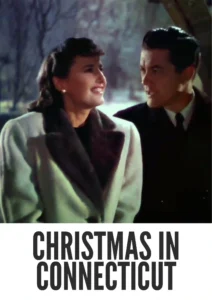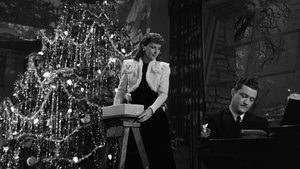Contact: info@alwanfilm.com
Video Sources 0 Views

Synopsis
Christmas in Connecticut 1945 Colorized Review: A Festive Rom-Com Classic

Introduction
Released in the post-war era of 1945, Christmas in Connecticut is a beloved holiday romantic comedy that has stood the test of time. Directed by Peter Godfrey and starring the effervescent Barbara Stanwyck, this heartwarming and witty film continues to charm audiences with its festive cheer, lighthearted humor, and touching romantic entanglements. The film offers a blend of mistaken identities, comedic situations, and a quintessentially 1940s take on the modern American woman, all wrapped up in the cozy glow of a Christmas setting. In this review, we will explore the film’s significance, its delightful performances, and its lasting legacy as a holiday favorite.
Check The Full Colorized Movies List
Check Our Colorized Movies Trailer Channel
Understanding Christmas in Connecticut 1945 Colorized: Director, Cast, and Genre
Director’s Vision
Christmas in Connecticut was directed by Peter Godfrey, a filmmaker who had a knack for blending comedy with romance, often adding a touch of the absurd. His directorial style is well-suited to the farcical nature of this film, where misunderstandings and deceptions form the crux of the plot. Godfrey’s direction keeps the film light and breezy, while also capturing the warmth and coziness associated with the holiday season. His vision emphasizes the contrasts between city life and rural simplicity, using the Christmas backdrop to heighten the sense of familial togetherness and festive celebration.
The Iconic Performance of Actors
At the heart of Christmas in Connecticut is Barbara Stanwyck’s portrayal of Elizabeth Lane, a sharp, independent food writer who writes an imaginary column about her idyllic life on a Connecticut farm. Stanwyck, known for her dramatic roles in films like Double Indemnity (1944), shines in this more comedic role, displaying impeccable timing and a delightful charm. She imbues Elizabeth with both vulnerability and wit, making her a relatable and lovable heroine.
Opposite Stanwyck is Dennis Morgan, who plays Jefferson Jones, a war hero invited to Elizabeth’s fictional farm for Christmas. Morgan’s affable and easygoing performance provides the perfect foil for Stanwyck’s slightly flustered character. Their chemistry is palpable, and their romantic entanglement forms the heart of the film’s charm.
Rounding out the cast is Sydney Greenstreet as the gruff and eccentric publisher Alexander Yardley, whose presence drives much of the film’s plot. His commanding screen presence and comedic timing add a delightful layer of humor to the film. S.Z. Sakall as Felix Bassenak, Elizabeth’s chef friend, is also a standout, providing much of the film’s comic relief with his endearing portrayal of a bumbling yet skilled cook.
Exploring the Genre
Christmas in Connecticut falls squarely within the romantic comedy genre but stands out due to its holiday setting, which adds an extra layer of warmth and joy to the narrative. The film expertly combines elements of slapstick comedy, romance, and situational farce, a hallmark of 1940s screwball comedies. At the same time, it also offers a commentary on the evolving role of women in post-war America, highlighting the tension between domestic expectations and professional ambitions.
The film’s Christmas setting enhances the atmosphere, creating a sense of nostalgia and warmth that is integral to its enduring popularity. It remains a perfect holiday movie, balancing romance with humor and delivering a satisfying happy ending wrapped in a festive bow.
Exploring the World of Christmas in Connecticut 1945 Colorized: Plot and Characters
Detailed Synopsis
The plot of Christmas in Connecticut revolves around Elizabeth Lane (Barbara Stanwyck), a popular food columnist who writes about her life on a picturesque farm in Connecticut, where she is supposedly the perfect housewife and mother. In reality, Elizabeth is a single woman living in a New York City apartment, and she knows nothing about farming or cooking. The entire persona she projects in her column is a fabrication, created with the help of her friend Felix (S.Z. Sakall), who supplies her with recipes and culinary advice.
The central conflict arises when Elizabeth’s boss, the gruff and imposing Alexander Yardley (Sydney Greenstreet), decides to invite war hero Jefferson Jones (Dennis Morgan) to spend Christmas at her “farm” as a publicity stunt. Since Elizabeth has no farm, no husband, and certainly no cooking skills, she must scramble to create the illusion of the life she’s been pretending to lead.
To complicate matters, Elizabeth’s fiancé John Sloan (Reginald Gardiner), who is as pompous as he is clueless, tries to help, but only adds to the chaos. As Elizabeth fakes her way through hosting Christmas at a borrowed farm, her carefully constructed facade starts to crumble, especially as she begins to fall for Jefferson, who is oblivious to the ruse.
The film is filled with comedic situations stemming from Elizabeth’s attempts to maintain the charade. From trying to cook Christmas dinner without any real skills to navigating the romantic tension between her and Jefferson, Christmas in Connecticut is a delightful comedy of errors that culminates in a warm and satisfying holiday ending.
The Complex Protagonist and Memorable Supporting Characters
Elizabeth Lane is a fascinating protagonist, as she embodies the complexities of being a modern woman in 1940s America. She is independent, career-driven, and witty, yet finds herself caught in the expectations of domesticity. Her character speaks to the broader societal issues of the time, particularly the role of women in post-war America, where there was a tension between traditional domestic roles and the desire for greater independence and professional fulfillment.
The supporting characters in Christmas in Connecticut are equally memorable. Felix Bassenak, played with a lovable charm by S.Z. Sakall, is a standout character who provides much of the film’s comic relief. His genuine warmth and bumbling nature make him an endearing part of the story, and his friendship with Elizabeth adds depth to her character. Sydney Greenstreet’s Alexander Yardley is the quintessential gruff boss with a heart of gold, while Dennis Morgan’s Jefferson Jones plays the role of the oblivious love interest with perfect sincerity.
The Art of Screwball Comedy in Christmas in Connecticut 1945 Colorized
Understanding Screwball Comedy
Christmas in Connecticut is a classic example of a screwball comedy, a genre that was popular during the 1930s and 1940s. Screwball comedies are known for their fast-paced dialogue, witty banter, and often outlandish situations. They often feature strong female characters and explore themes of class, gender roles, and societal expectations through humor.
In this film, the comedy arises from Elizabeth’s attempts to maintain her false identity while managing the chaos of her ever-growing web of lies. The rapid-fire dialogue, misunderstandings, and absurd situations are hallmarks of the screwball genre, and Christmas in Connecticut handles them with expert precision.
The Role of Women in Post-War America
Balancing Domesticity and Professionalism
One of the central themes in Christmas in Connecticut is the tension between Elizabeth’s career as a successful writer and the expectations of domesticity placed on her. During World War II, many women entered the workforce, taking on roles traditionally held by men. However, in the post-war era, there was pressure for women to return to their domestic roles as homemakers and wives. Elizabeth’s character embodies this conflict as she navigates her dual life as a professional woman who is expected to be an ideal homemaker.
The film subtly critiques the notion that a woman’s worth is tied to her ability to maintain a household, while also celebrating Elizabeth’s independence and ingenuity. Her success as a writer, even if based on a fabricated persona, highlights her intelligence and adaptability. The film’s humor often stems from her attempts to reconcile her real life with the fictional one she has created in her column.
Christmas in Connecticut and the Tradition of Holiday Films
The Importance of Setting
The Christmas setting of Christmas in Connecticut plays a crucial role in the film’s appeal. The holiday backdrop adds to the warmth and coziness of the story, creating a sense of nostalgia that resonates with audiences. The film’s depiction of a snowy Connecticut farm, complete with festive decorations and a bustling Christmas dinner, captures the essence of an idealized holiday celebration.
In the tradition of holiday films, Christmas in Connecticut uses the Christmas setting not only as a visual backdrop but also as a catalyst for the characters’ personal growth and romantic developments. The film’s message of love, family, and finding happiness in unexpected places aligns perfectly with the themes typically associated with Christmas films.
A Timeless Holiday Classic
Since its release in 1945, Christmas in Connecticut has become a staple of holiday viewing. Its charming blend of romance, comedy, and Christmas cheer ensures that it remains a beloved classic for audiences of all ages. The film’s timeless appeal lies in its ability to evoke the warmth and joy of the holiday season while delivering a witty and engaging story.
Reception and Critical Response
Initial Reception
Upon its release, Christmas in Connecticut was met with positive reviews from both critics and audiences. Barbara Stanwyck’s performance was widely praised, with many noting her versatility in transitioning from more dramatic roles to comedy. The film’s lighthearted tone and festive setting also made it a hit with post-war audiences, who were looking for escapism and joy during the holiday season.
Long-Term Legacy
Over the decades, Christmas in Connecticut has maintained its status as a holiday classic. It is regularly included in lists of the best Christmas films and continues to be shown on television during the holiday season. Its influence can be seen in later holiday films that combine romance and comedy, such as While You Were Sleeping (1995) and The Holiday (2006). The film’s enduring popularity speaks to its universal themes of love, family, and the joy of the holiday season.
Where to Watch Christmas in Connecticut 1945 Colorized Online
For viewers looking to experience Christmas in Connecticut, the film is widely available on popular streaming platforms, including Amazon Prime Video, HBO Max, and Turner Classic Movies. It is also available for purchase on DVD and Blu-ray, making it accessible for holiday viewing at home.
FAQs About Christmas in Connecticut 1945 Colorized
Q: Is Christmas in Connecticut a remake?
A: No, the 1945 version of Christmas in Connecticut is the original film. However, it was remade in 1992 as a made-for-TV movie directed by Arnold Schwarzenegger and starring Dyan Cannon.
Q: What makes Christmas in Connecticut a holiday classic?
A: The film’s festive setting, charming performances, and heartwarming story make it a quintessential holiday movie that captures the joy and warmth of the Christmas season.
Q: What is the significance of the character Elizabeth Lane in the context of 1940s cinema?
A: Elizabeth Lane represents the modern woman of the 1940s, balancing a successful career with the expectations of domesticity. Her character reflects the changing role of women in post-war America.
Conclusion
Christmas in Connecticut (1945) is a delightful holiday classic that continues to enchant audiences with its heartwarming romance, witty comedy, and festive cheer. Barbara Stanwyck’s charming performance, combined with Peter Godfrey’s lighthearted direction, makes this film a must-watch during the holiday season. Its themes of love, family, and the importance of being true to oneself resonate just as strongly today as they did in 1945. Whether you’re watching it for the first time or revisiting it as a holiday tradition, Christmas in Connecticut is a film that captures the magic of Christmas and the timeless appeal of classic Hollywood.














